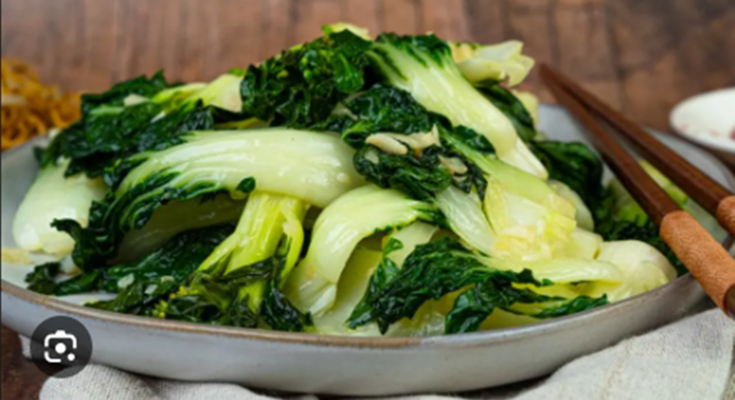Bok Choy Recipe: Bok Choy, also known as Chinese cabbage, is a staple ingredient in many Asian cuisines. Loved for its mild, slightly sweet flavor and crunchy texture, it’s incredibly versatile and easy to prepare.
Whether you’re whipping up a quick stir-fry, adding it to soups, or steaming it as a side dish, Bok Choy always delivers on taste and nutrition.
In this guide, we’ll walk you through a simple yet delicious Bok Choy recipe with step-by-step instructions.
What is Bok Choy?
Bok Choy has its roots in Chinese cuisine, where it has been a dietary staple for centuries. Its tender leaves and crisp stalks make it a unique ingredient that shines in various dishes. Nutritionally, Bok Choy is a powerhouse, packed with vitamins A, C, and K, as well as calcium, potassium, and antioxidants. It’s low in calories, making it a perfect choice for healthy eating.
There are two main varieties of Bok Choy:
- Baby Bok Choy – Smaller and more tender, ideal for steaming or quick stir-fries.
- Mature Bok Choy – Larger with broader leaves, often used in soups and stews.
Ingredients Needed for Bok Choy Recipe
Here’s what you’ll need for a simple and flavorful stir-fried Bok Choy:
- 1 pound of Bok Choy (baby or mature, your choice)
- 2 tablespoons of vegetable oil (or sesame oil for added flavor)
- 3 cloves of garlic, minced
- 1-inch piece of ginger, julienned
- 2 tablespoons of soy sauce
- 1 teaspoon of sesame oil (optional)
- Salt and pepper to taste
Optional add-ons:
- Red chili flakes for a spicy kick.
- A handful of mushrooms or tofu for added substance.
Essential Tools for Cooking Bok Choy
To get started, ensure you have the following tools on hand:
- A large wok or skillet for stir-frying.
- A sharp knife for slicing the Bok Choy.
- A colander for washing.
- A spatula or tongs for tossing the vegetables.
Setting up a clean and organized cooking station will save time and keep the process smooth.
How to Prepare Bok Choy for Cooking
Proper preparation is key to bringing out the best in Bok Choy. Begin by separating the leaves from the stalks. If you’re using mature Bok Choy, you’ll want to cut the stalks into smaller pieces for even cooking. Baby Bok Choy, on the other hand, can often be cooked whole or halved.
Cleaning Bok Choy:
- Fill a large bowl with water.
- Submerge the Bok Choy and swish it around to remove dirt and grit.
- Pay extra attention to the base of the stalks where dirt tends to collect.
- Rinse thoroughly under running water and pat dry with a clean towel.
Step-by-Step Guide to Cooking Bok Choy
Step 1: Heating the Pan or Wok
Heat your wok or skillet over high heat until it’s hot. Add 2 tablespoons of vegetable or sesame oil, swirling to coat the surface evenly. The key is to start with a hot pan to ensure quick cooking and preserve the crunch of the Bok Choy.
Step 2: Adding Aromatics
Once the oil is shimmering, toss in the minced garlic and julienned ginger. Stir quickly to release their fragrance but be careful not to burn them—30 seconds is usually enough.
Step 3: Stir-Frying the Bok Choy
Add the prepared Bok Choy to the pan, starting with the stalks (if using mature Bok Choy). Stir constantly for 2–3 minutes, then add the leafy parts. Stir-fry for another 2–3 minutes until the leaves wilt slightly but remain vibrant green.
Step 4: Adding Seasonings
Drizzle soy sauce and sesame oil over the Bok Choy, tossing to coat evenly. Add salt and pepper to taste. If you like a bit of spice, sprinkle in some red chili flakes. Stir for an additional minute, then remove from heat.
Variations of Bok Choy Recipes
Bok Choy is versatile enough to adapt to various cooking methods and flavors. Here are a few popular variations to try:
Bok Choy Soup
For a comforting and nutritious soup, add chopped Bok Choy to a clear broth. Simmer it with ingredients like mushrooms, tofu, or shrimp for added texture and flavor. Season with a splash of soy sauce and a drizzle of sesame oil. This light and hearty soup is perfect as an appetizer or a main dish on cooler days.
Bok Choy with Mushrooms
This combination brings out the earthy flavors of mushrooms, perfectly complementing the mild sweetness of Bok Choy. Stir-fry sliced shiitake or button mushrooms with garlic, then add Bok Choy and soy sauce. The dish is quick to make and pairs well with steamed rice or noodles.
Common Mistakes to Avoid When Cooking Bok Choy
Cooking Bok Choy may seem straightforward, but there are a few pitfalls to avoid:
- Overcooking: Bok Choy cooks quickly, so keep an eye on it. Overcooked Bok Choy loses its crisp texture and vibrant color.
- Using Too Much Oil: A little oil goes a long way. Excess oil can make the dish greasy and overpower the delicate flavors.
- Skipping the Cleaning Step: Dirt and grit can ruin the dish. Always rinse thoroughly, especially near the stalk base.
- Crowding the Pan: Overcrowding causes the Bok Choy to steam instead of stir-fry. Cook in batches if necessary to maintain high heat and proper texture.
Health Benefits of Including Bok Choy in Your Diet
Bok Choy is a nutritional powerhouse, packed with essential vitamins and minerals:
- Rich in Vitamin C: Boosts immunity and promotes skin health.
- Vitamin K: Supports bone health and aids in blood clotting.
- Calcium and Potassium: Essential for maintaining strong bones and healthy muscle function.
- Low in Calories: Ideal for those looking to maintain or lose weight without sacrificing nutrition.
Incorporating Bok Choy into your meals regularly can support overall health, improve digestion, and provide antioxidants that combat inflammation.
Serving Suggestions for Bok Choy
Wondering how to serve Bok Choy? Here are a few ideas:
- As a Side Dish: Serve stir-fried Bok Choy alongside grilled chicken, baked salmon, or tofu.
- Over Rice or Noodles: Use Bok Choy as a topping for steamed jasmine rice or stir-fried noodles for a quick and satisfying meal.
- In Buddha Bowls: Combine Bok Choy with quinoa, roasted veggies, and a drizzle of tahini dressing for a nutrient-packed bowl.
- With Dumplings: Steamed Bok Choy pairs wonderfully with dumplings or spring rolls for an Asian-inspired feast.
Storing and Reheating Cooked Bok Choy
Leftovers? No problem! Proper storage and reheating ensure your Bok Choy stays fresh and tasty:
Storing:
- Place cooked Bok Choy in an airtight container and refrigerate. It will stay fresh for up to 3 days.
- Avoid freezing, as the texture becomes mushy when thawed.
Reheating:
- Heat a pan over medium heat and add a splash of water or broth.
- Toss the Bok Choy for 2–3 minutes until heated through.
- Avoid microwaving, as it may result in uneven heating and sogginess.
FAQs about Bok Choy Recipe
What is bok choy?
Bok choy, also known as Chinese cabbage, is a leafy green vegetable with a mild flavor. It’s a staple in Asian cuisine and can be used in stir-fries, soups, and salads.
How do you prepare bok choy for cooking?
To prepare bok choy, wash the leaves thoroughly to remove dirt. Trim the base and separate the stalks if needed. You can chop it into smaller pieces for quicker cooking or leave the stalks whole for presentation.
What are the best ways to cook bok choy?
Bok choy can be sautéed, steamed, stir-fried, or added to soups. Quick cooking methods preserve its crisp texture and fresh taste. A popular method is stir-frying with garlic and soy sauce.
How long does bok choy take to cook?
Bok choy cooks quickly, usually within 5-7 minutes when stir-fried or steamed. The stalks may take a little longer than the leaves, so cook them first.
Can I eat bok choy raw?
Yes, bok choy can be eaten raw. It’s crunchy and slightly sweet, making it a great addition to salads or as a garnish.
Is bok choy healthy?
Bok choy is packed with nutrients, including vitamins A, C, and K, as well as calcium and fiber. It’s low in calories and a fantastic choice for a healthy diet.
What dishes pair well with bok choy?
Bok choy pairs well with Asian-inspired dishes like stir-fried noodles, dumplings, or grilled meats. It also complements rice and tofu dishes.
Conclusion
Bok Choy is a culinary gem that deserves a place in your kitchen. Its simple preparation and delightful versatility make it an excellent choice for quick, healthy meals. Whether stir-fried, added to soups, or paired with other ingredients, Bok Choy never fails to impress. So, roll up your sleeves, gather your ingredients, and give this recipe a try. You might just discover a new favorite dish!



